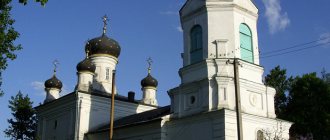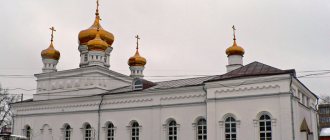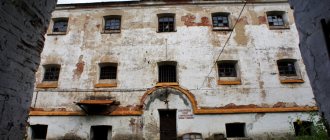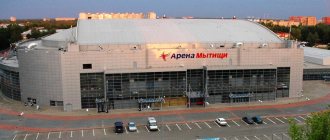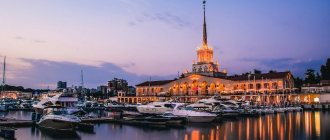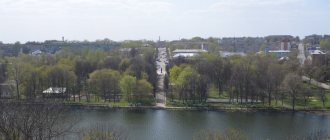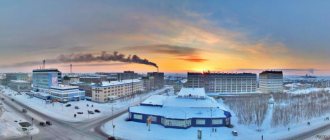Hello, dear readers! No, this photo is not Paris, not Rome, or any European city. This is my native, beloved, beautiful city of Glazov with beautiful, old and new historical places, which you definitely need to walk through in order to feel, feel what and how our town lives. It is these and other important sights of Glazov that I will tell you now.
Those who live far away and don’t know that there is such a town in the Urals, you can look at a map of Udmurtia and roughly determine the location. Now the people are already literate and can easily find our republic and city on the map of Russia!
Glazov residents are surprised when people living outside Udmurtia say that we are somewhere near Yakutia or in the Far East. To the question: “Where is Glazov?” they answer: “Do you know Izhevsk? Well, this is where motorcycles, IZH cars, Kalashnikov assault rifles are made, and now “Buranovsky grandmothers have joined in,” so here it is – nearby.”
War memorial on Freedom Square
This landmark was erected in the city of Glazov for the 25th anniversary of the great victory of Soviet soldiers over the Nazis in 1975. The war memorial is presented in the form of a sculpture depicting two soldiers, a memorial plaque with the names of heroes who gave their lives in the war and a tall spire.
The memorial area is always well maintained. Local residents and tourists lay fresh flowers at the monument all year round.
It is noteworthy that this monument was dismantled several times; once again it was reconstructed in 2007.
Location: Freedom Square.
Settlement "Indakar"
The famous archaeological site is located just 4 km from Glazov. “Indakar”, translated from the Udmurt language, means “city of the hero”.
Researchers have established that the age of the medieval settlement reaches eight to eleven centuries. The most likely time of construction of the settlement of the Finno-Ugric peoples is the end of the 9th – beginning of the 13th century.
In ancient times, the large fortified settlement of Indakar was located on a high hill. Archaeologists have established what the Chepetsk settlement looked like many centuries ago.
Despite its venerable age, the base of the wooden frames is well preserved.
Using the example of reconstructed dwellings, tourists will understand what life was like for the peoples of Udmurtia in the early Middle Ages.
Thousands of objects belonging to our ancestors were found in the Indakar reserve museum. Research into the Chepetsk settlement continues today.
Tools, dishes, jewelry, things, talismans, amulets, wooden statues of gods, remains of furnaces for cheese-blowing iron smelting and other valuables. Tourists are amazed by the fine work of ancient masters.
Socio-cultural
In 1951, a palace of culture was built in the city of Glazov, called “Russia”. This building was erected in the so-called “Stalinist Empire” style.
The monumental building with adjacent linden alleys, monuments and a fountain became a real decoration for the post-war city. They, together with the now socio-cultural ones, are still the most famous attractions of Glazov.
Famous people perform on the stage of this cultural palace, and there are clubs and sections.
Location: Sovetskaya street - 29.
Sights of the city of Glazov (Udmurtia)
The ancient Udmurt town of Glazov has its own unique architectural appearance. During the 19th and early 20th centuries, beautiful wooden mansions with carved decorations and brick houses in Art Nouveau and Neo-Baroque styles appeared on the streets of the city.
Many buildings are well preserved. Russian wooden architecture always inspires admiration.
Tourists noticed that Glazov residents monitor the condition of old houses. It is clear that people do not want to live in dullness. Painted shutters, restored facades - this is how many ancient buildings look.
Where to start a tour of this amazing city? Of course, from Freedom Square. Here is one of the popular attractions of Glazov.
Glazov Museum of Local Lore
The museum was founded in 1918. Today, within its walls there are 8 exhibition halls dedicated to various topics.
The most extensive collections are considered to be collections of household items, musical instruments, ancient coins, and so on.
Museum workers can provide tourists with the opportunity to attend an excursion program designed in folk style; tourists can also purchase a tour from the museum, which gives them the opportunity to get acquainted with the sights of the city and its surroundings.
Location: Kirova street - 13.
Interesting items
Excavations began in 1885. They were studied by archaeologist A. A. Sinitsyn and local historian N. G. Pervukhin. Scientists are still working at this site, and research is also being carried out on the found everyday and cultural objects. It's hard to believe, but these days we can even see wooden frames that are still well preserved. In addition, the Idnakar Museum contains more than a thousand artifacts found during excavations. Among them are the remains of craft tools, dishes, amulets, and jewelry. The Idnakar settlement is protected as an archeological monument of national importance.
Monument to Pavlik Morozov
In the city of Glazov, tourists can see a monument to Pavlik Morozov, a boy who denounced his father to the security officers and was killed at the hands of his relatives. The height of the monument is 2 meters.
The boy stands on a high pedestal, he is depicted in clothes flowing from the gusts of wind, a red tie is tied around the child’s neck, and a cap is put on his head. There is a plaque on the monument containing some information about the young pioneer.
The sculpture is located in the park, tourists come to it and lay flowers at the foot. Some creative tourists wear various hats over the Pavlik cap, and tie ties or bow ties around their necks.
Location: Sovetskaya and Kirova streets (intersection, in the city park).
Church of the Transfiguration
The building of this religious center was built in 1887. During the period of Soviet power, it was partially damaged - half of the buildings were completely demolished.
The wooden church building was first built back in 1750 with funds collected by newly baptized Udmurts; it was called the chapel of St. Nicholas the Wonderworker.
Subsequently, a stone church was built in its place, which was already called the Church of the Transfiguration.
During the Soviet period, the surviving buildings of the church housed a sports school and a cinema. Today this building is being reconstructed; subsequently it is planned to join the new church, with which it will form a religious complex.
Location: Freedom Square - 10a.
Historical and cultural museum-reserve "Idnakar"
The scope of this city attraction includes: the archaeological monument “Soldyr settlement Idnakar IX - XIII centuries. BC”, which has the status of an object of federal significance, and, accordingly, a museum building with exhibitions located in it.
Idna is the name of a historical character, batyr, kar is a settlement or ancient settlement. At its core, Idnakar is a settlement named after the local legendary hero. The settlement is a military fortress, simultaneously combining the role of an administrative center, built by the northern Udmurts.
The local settlement was headed by a ruler, as evidenced by a bone seal found during archaeological excavations.
In the museum, tourists can visit exhibitions dedicated directly to Idnakar, presented in the form of objects found at excavation sites, and exhibitions telling about the nature of the north of Udmurtia.
Since 1999, a permanent exhibition dedicated to the everyday life, life and craft of the medieval inhabitants of the settlement has been created for visitors to the museum-reserve. Visitors can see a model of the reconstruction of a medieval burial.
Idnakar today is the only monument of its kind dedicated to the culture of the Finno-Ugric peoples. Its area is 4 hectares.
Location: Sovetskaya street - 27/38.
Ancient sights of Glazov
In order to see the ancient settlement, it is enough to drive 4 kilometers from the city. It is called the Idnakar settlement or the first Soldyr settlement. The sights of Glazov are interesting because they help you learn the history of Udmurtia and the customs of its inhabitants in ancient times.
The city of Idnakar received its name from the Udmurt warrior Idna, who became its founder in the 9th century. The settlement was a craft, trade and cultural center for four centuries. Archaeological excavations helped everyone see the dwellings of the ancient Udmurts and their household items.
Monument to the Janitor
A representative of the most useful profession - a janitor, cast in bronze - can be seen on Shkolnaya Street. The author of the project is sculptor Vladimir Kelm. The monument was cast in the city of Tchaikovsky.
Initially, it was proposed to immortalize in bronze a girl in a baseball cap holding a broom, this was due to the fact that the majority of janitors in Glazov are women. However, subsequently it was decided to cast a statue of a man 2 meters tall.
A huge number of people come to the monument every day and take pictures against its background.
Location: Kirova street.
Climate and ecology of Glazov
Glazov is located in the temperate continental zone. Winters here are not that cold. In total, there is frost for 2-3 weeks during the winter. Basically, the temperature does not exceed 20-24C, but in summer the weather is very changeable. One day the temperature can reach +35C, and the next it drops to 19-20C. There is also a strong imbalance in temperature at different times of the day.
Glazov is known throughout Udmurtia as the “greenest” city. There really are a lot of trees here, which makes it look great at any time of the year. Mostly poplars, birch and apple trees grow here.
View of the new area
Until recently, Glazov was considered the most polluted city in Udmurtia; many residents are sure that Glazov is radioactive. The “Chepetsk Mechanical Plant” with its uranium production and constant waste emissions into the Cheptsa River, the main drinking source of the townspeople, was to blame for all the rumors and speculation.
ChMZ tailings dump. Photo: https://glazov-retro.info/
Competent services monthly assure Glasovka residents that the environmental situation in the city is good and the indicators do not exceed acceptable standards. And this despite the fact that the city is often watered by yellow rains, and that the number of surgical removals of tumors here is the largest in the republic. The area close to the city is littered with heaps of garbage the size of a football field. Although Glazov itself is quite clean.
Of course, work is underway to improve the environment, for example, in 2005, Glazovsky CHPP-1 was switched from coal to gas, and its emissions have already been reduced by 30 times. Large amounts of money are being invested in water supply sources for further reconstruction. Perhaps then there will be water here that you can drink from the tap.
It should be noted that all this is sponsored by CMP money; the plant’s annual sponsorship reaches tens and even hundreds of millions of rubles.
Monument to T. Baramzina
Few people know Tatyana Baramzina, a Soviet sniper warrior. However, in the city of Glazov, where she was born, the girl Tanya, who died at the hands of the Nazis, is considered a hero.
During a shootout near the village of Pekalino (Belarusian SSR), she personally destroyed 20 fascists until she ran out of ammunition.
In 1945, Tatyana Baramzina was awarded the title of Hero of the USSR posthumously. In her hometown of Glazov, a monument was erected to the girl; the author is the sculptor B.P. Barkov. Tourists can see this attraction in the Maxim Gorky Park of Culture and Leisure.
Location: Park of Culture and Leisure named after. A.M. Gorky.
Infrastructure condition
The housing and communal complex of Glazov is quite well developed. The main reason for this is the large number of housing and communal services companies and housing offices, which are in constant competition for customers. Therefore, city residents always have a choice.
But, despite this, the amounts in receipts tend to increase with frequent variability, and the range of paid services is not performed properly: the staircases of houses are rarely washed, most entrances do not have benches and trash cans, the surrounding area is cleaned well, but rarely.
Very often there are interruptions in the power supply and water supply, sometimes it is turned off without warning. The condition of the water itself leaves much to be desired, and this despite the fact that the Glazov Municipal Unitary Enterprise “Vodokanal” was awarded the title of the best enterprise in Russia in this field. But things are going well with the heating; it is turned on at the scheduled time and in sufficient volume to maintain a good temperature in the apartment.
Road wars
The road situation in the city is quite tense. Even the central street of Glazov looks like a sieve of potholes and hummocks, let alone the secondary streets and especially the courtyards. Of course, potholes are often patched up hastily, but the effect lasts no more than 3-4 months.
Road surface on the street. Dzerzhinsky
Despite the small population, there are a lot of cars here, so traffic jams during rush hour have become commonplace, but during the day and late evening it is not difficult to get from one end of the city to the other.
The bus is the only type of public urban transport with a large number of routes covering all corners of the city and surrounding areas.
Monument to V. G. Korolenko
Almost in the very center of Glazov there is a monument to the great writer V. G. Korolenko. It is presented in the form of a bust of a man whose arms are folded on his chest. Instead of legs, a pedestal was built near the monument, on which the name of the writer and the years of his stay in Glazov are engraved.
This monument was erected to the writer not only for his creative work, but also for the fact that he was exiled to this city in 1879, accused of agitating revolutionary ideas and communist propaganda.
Location: Korolenko street.
General information and history of Glazov
Glazov is the northern capital of Udmurtia. It is located on the left bank of the Cheptsa River, on a hilly plain 1106 km from Moscow. The highest point is Mount Soldir (176.2 m above level), which offers a beautiful view of the entire city.
Panoramic view of the city
More than 95,000 people live in Glazov, mostly people over 30-40 years old, all young people leave for institutes and most of them do not return.
According to one version, Empress Catherine II gave this name to the city after seeing a drawing of the development of the district village. It was she who granted Glazov the status of a city in 1780, despite the fact that the population at that time did not exceed 500 people. But the first mention of the Glazovo settlement in written sources was recorded 120 years earlier.
The general development plan, created by the architect F.M. Roslyakov, was approved in 1804. The main concept of the development was a fan-arc type of layout, according to which all the main streets converged into one square (Freedom Square), which is decorated with the Transfiguration Cathedral, restored after the Bolsheviks.
Chapel of Alexander Nevsky
In 1837, Emperor Alexander II visited the city of Glazov. In honor of this event, it was decided to erect a chapel in the city, later named the Alexander Nevsky Chapel. During the Soviet period, this cultural and historical site was demolished and is currently being reconstructed.
Location: street Pervomaiskaya and Molodaya Gvardiya streets (at the intersection).
Glazov Municipal Theater
In 1983, in Glazov, through the activities of the director, a folk theater was founded, which in 1987 received its name “Paraphrase”.
The theater takes part in numerous festivals and has a huge number of awards. Tourists visiting Glazov speak very warmly about visiting this cultural center.
Location: Sovetskaya street - 19.
Pipe of unfinished CHPP-2
Within the city there is one very interesting attraction - pipes 200 meters .
The territory where the abandoned pipe stands was supposed to become the site for the construction of another thermal power plant, but with the collapse of the USSR the project was frozen.
Now this technical facility acts as a training place for extreme sports enthusiasts, who climb to the very top of the pipe and view the panorama of the city from above.
Location: street.
Gorky Park
This favorite vacation spot for tourists and local residents can rightfully be called a landmark of the city of Glazov. Along the entire perimeter of the park there are attractions and sculptures of characters from fairy tales and children's favorite cartoons.
Theatrical programs are held on the territory of the park, which are organized by socio-cultural employees.
Location: Komsomolskaya street - 16.
Regional historical and local history museum complex
In the halls of the museum there are household items, ancient coins, musical instruments, jewelry, national costumes collected during ethnographic expeditions.
The bulk of the exhibits were brought from the villages of Zolotaryovo and Kochishevo, located in the Glazov region.
Museum staff often conduct field trips. On national holidays, museum workers organize ethnographic festivals in nature.
In the vicinity of Glazov there are masterpieces of Russian wooden architecture and an ancient settlement. These historical and cultural monuments are the national treasure of Udmurtia.


